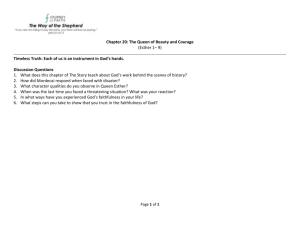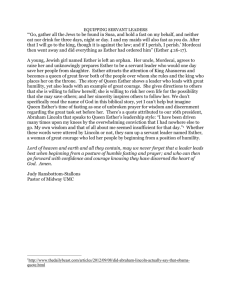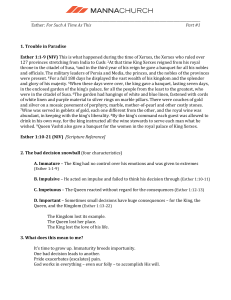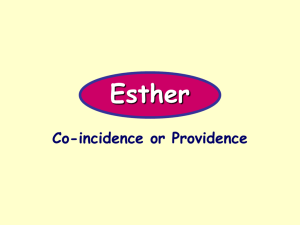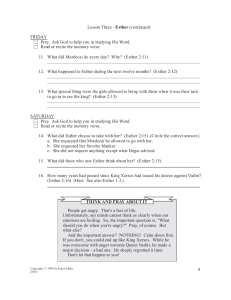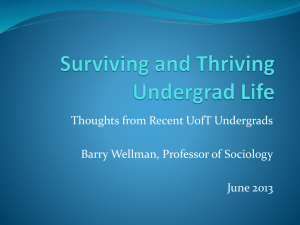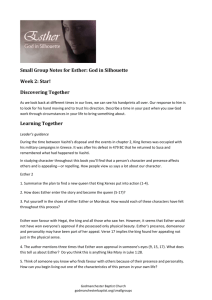Sylvia Plath*s The Bell Jar
advertisement
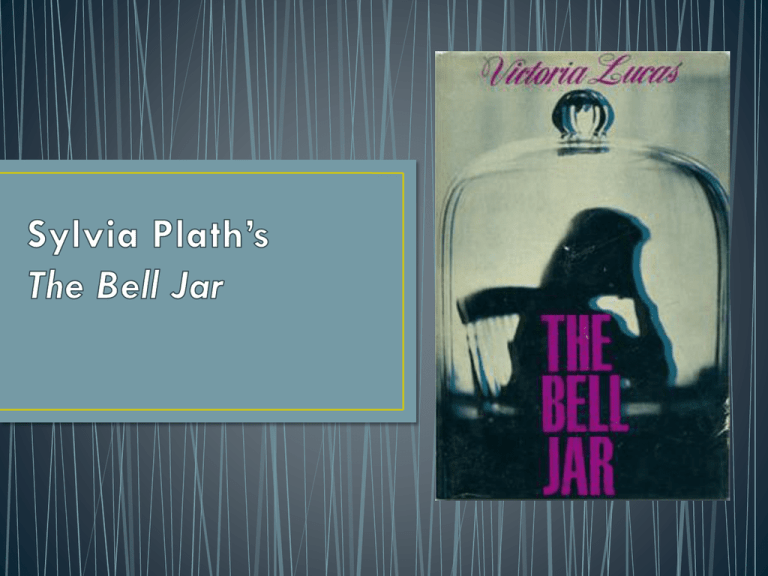
• http://www.youtube.com/watch?v=_Q0P94wyBYk • Can today’s women “have it all”? Explain. • Read the article “She Works. They’re Happy,” and answer the following questions: • List 4 gains women have made since the 1950s. • What are some conflicts that have arisen as a result of women’s elevating status? • What are some ways in which women are still unequal? • Identify point of view & tone using opening chapter. • Analyze the significance of setting and historical context. • Begin analyzing major characters and portrayal of gender. • Analyze emerging motifs and symbols in key scenes. • Esther’s view of herself: • View of others: • Tone of narration: • Reliable or unreliable? Why? • What is the historical context of the novel? • Physical setting? • How does Esther fit into her environment? Provide a supporting quote and page # for this. • What is the historical context of the novel? • Physical setting? • How does Esther fit into her environment? Provide a supporting quote and page # for this. • Doreen • Betsy • Buddy Willard • Jay Cee • Rosenberg execution & Esther’s reaction (p. 1-2) • Doreen and Esther go to Lenny Shepherd’s & “Elly Higginbottom” (p. 16-17) • Esther’s reflection in the elevator mirror (p. 18-19) • The significance of baths for Esther (p. 19) • The “talk” with Jay Cee & Esther’s flashback to her college classes (p. 31-33) • The Ladies Day banquet—gorging and ptomaine poisoning (p. 43-47) • Identify elements of Sylvia Plath’s life that influenced her work and themes • Read the biography from Contemporary Authors Online, and highlight the following content: • Important personal events (make a bulleted outline of these after reading) • Most significant written works • Mental disorders • Common motifs and themes in her work • An analytical quote about The Bell Jar (in the margins, explain whether it is favorable or unfavorable) • An analytical quote about Plath’s poetry • An analytical quote about Plath’s legacy • Use close reading techniques to analyze a scene for literary significance. • Write a well-organized paragraph analyzing your assigned scene. • Discuss your findings with a small group and with the class. 1. Begin with a topic sentence identifying your scene and its overall significance (i.e. in terms of developing a character, symbol or motif, conflict, etc.) 2. Analyze the importance of the scene, being sure to use relevant literary terminology, as appropriate. 3. Integrate at least one quote. 4. In your concluding sentence, give some indication of how this scene might be related to a larger theme of the work. 5. After meeting with your small group, write a brief reflection beneath your paragraph, highlighting something your discussion added to your understanding of the scene. “At last, obediently, like the mouth of a ventriloquist's dummy, my own mouth started to quirk up…” • Identify and employ the traits of stream of consciousness in a short writing piece. • Analyze the section in which Esther has a mental breakdown and its importance structurally to the narrative. • 1. As Esther heads back home to Boston for the summer, why does she look like a “sick Indian”? How does she feel wearing Betsy’s clothes? What motif is being developed here? • 2. “The gray, padded car roof closed over my head like the roof of a prison van, and the white, shining, identical clapboard houses… proceeded past, one bar after another in a large but escape-proof cage” (114). What does Esther’s description of the suburbs suggest about her mental state? • 3. Who is Dodo Conway, and what is Esther’s opinion of her? What does this suggest about Esther? • 4. Identify 5 signs that Esther’s mental condition is rapidly deteriorating. • 5. Describe Esther’s encounter with Dr. Gordon. What does she judge him for? Are her judgments fair or a result of her state of mind? • 6. What is the significance of the scene in which Esther meets the sailor? • 7. Describe the private hospital in Walton and Esther’s reaction to the patients. What is her first encounter with EST like? • 8. On p. 146, how is it clear that Esther’s mother does not understand her daughter’s condition? • 9. Give 3 examples of how Esther “fails” to end her life. Why is she unable to follow through each time? • 10. What is Esther supposed to do as a volunteer at the hospital? What happens after just one day? • 11. Analyze Esther’s experience at the graveyard, including her musings on Catholicism. What psychological factors are probably at play? In searching for her father’s grave, what do you think Esther is really searching for? • 12. How does Esther resolve to end her life at the end of Ch. 13? • 13. What is the significance of the headlines Esther occasionally includes in the narrative (p. 136 and 146)? • Analyze some of Plath’s poems for similar motifs and imagery found in The Bell Jar. • Write your own poem inspired by Plath’s confessional style. • Label was first used by the critic M.L. Rosenthal, who referred to Robert Lowell as a poet who reveals to his readers aspects of his private life that would conventionally be kept hidden, unless one were confessing to a priest (or in therapy with a psychiatrist) • Autobiographical manner of addressing personal experiences: depression, relationships, confusion, death, trauma, psychological breakdowns, etc. • Emerged in the late 1950s and early 1960s in the works of Sylvia Plath, Robert Lowell, and Anne Sexton (among others) • Diagnose Esther’s condition using the symptoms of mental illness. • Analyze the section detailing Esther’s recovery and its function in the narrative • bell jar (noun) • 1. a bell-shaped glass cover used for covering delicate objects or used in a laboratory, typically for enclosing samples. • 2. an environment in which someone is protected or cut off from the outside world. • 1. Describe the imagery used to describe Esther’s experience on p. 170-171. What is it effective at capturing? • 2. What does Esther’s request for a mirror and her subsequent breaking of it represent? • 3. What seems to be going on with Esther from pages 177-179? (Consult the mental illness worksheet.) • 4. What does Esther’s mother say on p. 179 that shows her lack of understanding about Esther’s condition? • 5. In this section, Esther engages in unacceptable, anti-social behavior. Find 2 examples of this. • 6. Who is Philomena Guinea? Why has she taken an interest in Esther? How does Esther react? • 7. What does Esther say about being trapped in a bell jar? Contrast this with the image at the bottom of p. 185. • 8. How is Dr. Nolan different from Dr. Gordon? How does Esther let her past experience inhibit her from welcoming treatment under Dr. Nolan’s care? • 9. Describe some of the other patients such as Valerie and Miss Norris. How do they represent various “success” or “failure” cases in the treatment of mental illness? • 10. Who shows up unexpectedly at the asylum? Why does she say she is there? Do you believe her story? • 11. How does Esther feel about her mother coming to visit? Why? • Evaluate whether the ending of the novel fulfills the requirements of a bildungsroman. • Analyze structure and style • Identify and interpret character foils, motifs, symbols, and themes • 1. Why is Esther worried about being transferred to Belsize? • 2. What does Esther mean when she says, “Joan was the beaming double of my old, best self, specially designed to follow and torment me”? • 3. What happens to cause Esther to think Dr. Nolan has betrayed her? How does the experience turn out differently from the way Esther expects? • 4. What happens to cause Esther to say, “the bell jar hung suspended a few feet above my head. I was open to the circulating air”? How does this contrast with her earlier comments about the bell jar? • 5. Find Joan’s comments about Mrs. Willard. How do they compare and contrast to thoughts Esther has had about mothers? • 6. How does Esther define her relationship with Joan? Find a quote from p. 219. • 7. How does Esther respond when Joan makes a pass at her? • 8. What causes Esther to think “I am climbing to freedom, freedom from fear, freedom from marrying the wrong person…”? • 9. Describe Esther’s encounter with Irwin. How does it confirm and/or refute Esther’s notions about sexuality and gender? • 10. What happens to Joan, and how does Esther respond? What does this say about Esther’s evolving identity crisis? • 11. What does Esther worry about in the final chapter? What do you suppose will be Esther’s fate once she leaves the asylum? • 12. The author ends the novel (p. 242-244) with contrasting images of birth and death. Describe the two scenes. How do they connect to other scenes throughout the novel and help contribute to one of the overarching themes? • What types of female characters surround Esther? Are any of them positive role models? Ultimately, why does Esther reject each of them? • What about males? Are there any positive male depictions in the novel? • Can you identify any pairs of foils? • Ch. 1-9: Esther in New York as summer intern at Ladies’ magazine • Ch. 10-13: Esther at home in Massachusetts, descending into madness, attempting suicide • Ch. 14-20: Esther’s therapy & recovery (?) • In what ways does Esther “come of age” throughout the novel? • Non-linear, episodic, stream-of-consciousness, disorienting, sometimes hallucinatory prose • Why? What literary effect does style have on the narrative and our understanding of the narrator? • The breaking of Esther’s leg while skiing symbolizes the tragic reality that freedom is an illusion for women living in a man’s world. • Esther’s doomed magazine photo shoot illustrates that patriarchal systems which confine women to rigid gender roles restrict female self expression. • Plath uses the motif of tabloid headlines to posit that a culture fixated on sensationalized news becomes desensitized to actual human suffering. • Thirty years after women became 50 percent of the college graduates in the United States, men still hold the vast majority of leadership positions in government and industry. This means that women’s voices are still not heard equally in the decisions that most affect our lives. In Lean In, Sheryl Sandberg examines why women’s progress has stalled and offers compelling, commonsense solutions that empower women to achieve their full potential. • “[Fighting] to give women and girls a fighting chance isn’t just a nice thing to do. It isn’t some luxury that we only get to when we have time on our hands. This is a core imperative for every human being in every society. If we do not continue the campaign for women’s rights and opportunities, the world we want to live in — and the country we all love and cherish — will not be what it should be.” • --“The Shriver Report: A woman’s nation pushes back from the brink.”
